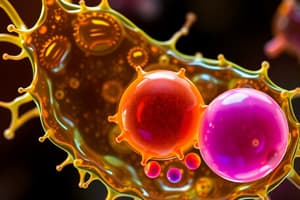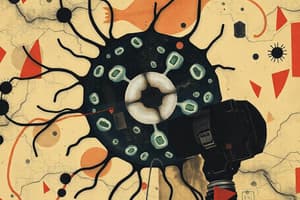Podcast
Questions and Answers
Which of the following best describes the relationship between a community and an ecosystem?
Which of the following best describes the relationship between a community and an ecosystem?
- A community includes the physical environment, while an ecosystem only includes living organisms.
- An ecosystem is a smaller, more specific version of a community.
- A community consists of different populations interacting in an area, while an ecosystem includes these communities along with their physical environment. (correct)
- Ecosystems and communities are the same thing.
If a mutation occurs in a somatic cell (non-sex cell), which of the following is the most likely outcome?
If a mutation occurs in a somatic cell (non-sex cell), which of the following is the most likely outcome?
- The mutation will automatically be corrected by DNA repair mechanisms.
- The mutation will definitely result in a beneficial adaptation for the organism.
- The mutation will be passed on to the organism's offspring.
- The mutation may affect the organism but will not be inherited by its offspring. (correct)
Which cellular organelle is responsible for modifying, sorting, and packaging proteins and lipids?
Which cellular organelle is responsible for modifying, sorting, and packaging proteins and lipids?
- Lysosome
- Golgi apparatus (correct)
- Mitochondria
- Endoplasmic reticulum (ER)
Imagine a scenario where a population of insects is exposed to a new pesticide. Over several generations, the population develops resistance to the pesticide. Which of the following evolutionary mechanisms best explains this phenomenon?
Imagine a scenario where a population of insects is exposed to a new pesticide. Over several generations, the population develops resistance to the pesticide. Which of the following evolutionary mechanisms best explains this phenomenon?
During DNA replication, which enzyme is responsible for unwinding the DNA double helix?
During DNA replication, which enzyme is responsible for unwinding the DNA double helix?
Which of the following is an example of commensalism?
Which of the following is an example of commensalism?
Which of the following best describes the role of tRNA in translation?
Which of the following best describes the role of tRNA in translation?
Which of the following is a key difference between mitosis and meiosis?
Which of the following is a key difference between mitosis and meiosis?
Which of the following is the primary function of chloroplasts?
Which of the following is the primary function of chloroplasts?
Which level of biological organization includes all other levels?
Which level of biological organization includes all other levels?
Flashcards
What is Biology?
What is Biology?
The scientific study of life, exploring structure, function, evolution, and distribution of living organisms.
Cell Theory
Cell Theory
All living organisms are composed of cells.
Gene Theory
Gene Theory
Heredity occurs through genes, which are units of inheritance.
Evolution
Evolution
Signup and view all the flashcards
Homeostasis
Homeostasis
Signup and view all the flashcards
Cells
Cells
Signup and view all the flashcards
Nucleus
Nucleus
Signup and view all the flashcards
DNA Replication
DNA Replication
Signup and view all the flashcards
Transcription
Transcription
Signup and view all the flashcards
Natural Selection
Natural Selection
Signup and view all the flashcards
Study Notes
- Biology is the scientific study of life
- It explores the structure, function, growth, origin, evolution, distribution, and taxonomy of living organisms
Core Principles of Biology
- Cell theory: All living organisms are composed of cells
- Gene theory: Heredity occurs through genes, units of inheritance
- Evolution: Populations evolve over time
- Homeostasis: Living organisms maintain a stable internal environment
Levels of Biological Organization
- Molecules: Atoms combine to form molecules, such as DNA and proteins
- Cells: Basic unit of life, consisting of organelles and other structures
- Tissues: Groups of similar cells performing a specific function
- Organs: Structures composed of different tissues working together
- Organ systems: Groups of organs that cooperate to perform major bodily functions
- Organisms: Individual living entities
- Populations: Groups of individuals of the same species living in a specific area
- Communities: Assemblages of different populations living and interacting in an area
- Ecosystems: Communities and their physical environment
- Biosphere: All ecosystems on Earth
Cell Structure and Function
- Cells are of two types: prokaryotic and eukaryotic
- Prokaryotic cells lack a nucleus and other membrane-bound organelles
- Eukaryotic cells possess a nucleus and other membrane-bound organelles
Cell Organelles
- Nucleus: Contains the cell's genetic material (DNA) and controls cell activities
- Endoplasmic reticulum (ER): Involved in protein and lipid synthesis
- Golgi apparatus: Modifies, sorts, and packages proteins and lipids
- Mitochondria: Powerhouse of the cell, produces ATP through cellular respiration
- Chloroplasts: Found in plant cells, site of photosynthesis
- Lysosomes: Contain enzymes for intracellular digestion
- Ribosomes: Site of protein synthesis
Cell Membrane
- Phospholipid bilayer with embedded proteins
- Regulates the movement of substances in and out of the cell
- Involved in cell signaling and communication
Cell Communication
- Cells communicate through chemical signals
- Signal transduction pathways convert signals into cellular responses
Cell Cycle and Division
- Cell cycle: Sequence of growth, DNA replication, and division
- Mitosis: Cell division that produces two identical daughter cells
- Meiosis: Cell division that produces four genetically different daughter cells (gametes)
Genetics
- Genes are units of heredity made of DNA
- DNA: Deoxyribonucleic acid, carries genetic information
- Chromosomes: Structures made of DNA and proteins that contain genes
- Genotype is the genetic makeup of an organism
- Phenotype is the observable characteristics of an organism
- Inheritance: Transmission of traits from parents to offspring
DNA Replication
- The process of copying DNA
- Helicase unwinds the DNA double helix
- DNA polymerase synthesizes new DNA strands
Transcription
- The process of synthesizing RNA from a DNA template
- RNA polymerase is the enzyme that catalyzes transcription
Translation
- The process of synthesizing proteins from RNA
- Ribosomes are the site of translation
- tRNA molecules bring amino acids to the ribosome
Mutations
- Changes in the DNA sequence
- Can be spontaneous or induced by mutagens
- Can be harmful, beneficial, or neutral
Evolution
- Change in the heritable characteristics of biological populations over successive generations
- Natural selection: Differential survival and reproduction of individuals with advantageous traits
- Adaptation: Traits that enhance survival and reproduction in a specific environment
- Speciation: The process by which new species arise
Evidence for Evolution
- Fossil record: Provides evidence of past life forms
- Comparative anatomy: Similarities in the anatomy of different species
- Embryology: Similarities in the development of different species
- Molecular biology: Similarities in the DNA and protein sequences of different species
Classification of Living Organisms
- Taxonomy: The science of classifying organisms
- Three domains of life: Bacteria, Archaea, and Eukarya
- Eukarya includes four kingdoms: Protista, Fungi, Plantae, and Animalia
Ecology
- The study of the interactions between organisms and their environment
- Populations: Groups of individuals of the same species living in a specific area
- Communities: Assemblages of different populations living and interacting in an area
- Ecosystems: Communities and their physical environment
- Biosphere: All ecosystems on Earth
Ecosystem Components
- Biotic factors: Living organisms
- Abiotic factors: Non-living components, such as temperature, light, and water
Ecological Interactions
- Competition: Organisms compete for resources
- Predation: One organism (predator) feeds on another organism (prey)
- Symbiosis: Close interactions between different species
- Mutualism: Both species benefit
- Commensalism: One species benefits, the other is not affected
- Parasitism: One species benefits, the other is harmed
Energy Flow in Ecosystems
- Producers: Autotrophs that produce their own food through photosynthesis or chemosynthesis
- Consumers: Heterotrophs that obtain energy by feeding on other organisms
- Decomposers: Break down dead organisms and organic matter
Food Chains and Food Webs
- Food chain: Linear sequence of organisms through which nutrients and energy pass
- Food web: Interconnected network of food chains
Biomes
- Major regional or global biotic communities, characterized by climate and vegetation
- Examples: Tropical rainforest, desert, grassland, tundra
Human Impact on the Environment
- Pollution: Contamination of the environment with harmful substances
- Deforestation: Clearing of forests
- Climate change: Changes in global temperature and weather patterns
- Loss of biodiversity: Reduction in the variety of life on Earth
Studying That Suits You
Use AI to generate personalized quizzes and flashcards to suit your learning preferences.




